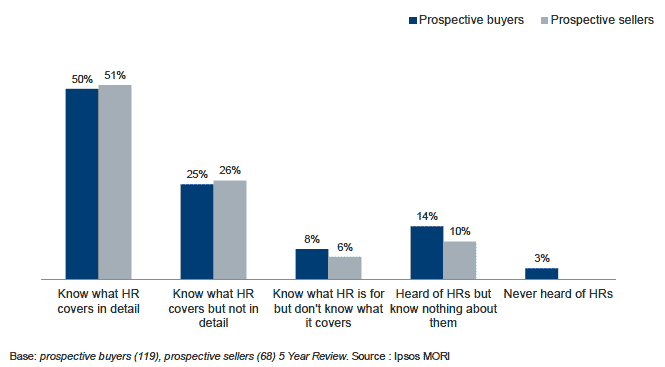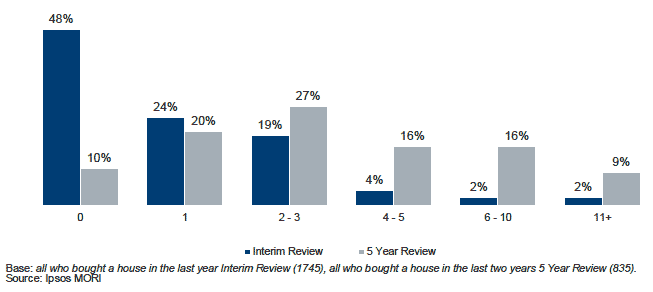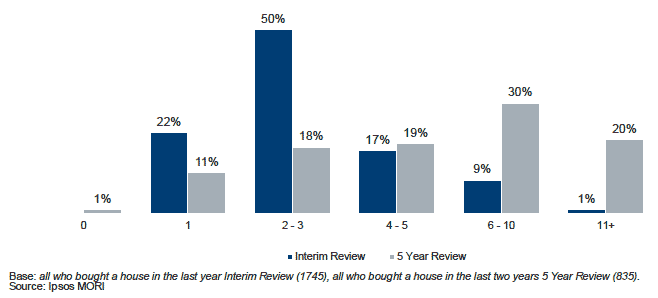Research to Inform the Five Year Review of the Home Report
Conducted to inform the five-year review of the Home Report. This research followed on from, and was informed by, the Home Report public consultation launched on 5 December 2013. The research study was conducted by Ipsos MORI and Retties and Co. and examined how the Home Report has performed over the past 5 years.
3 Awareness and understanding
3.1 This section sets out the extent to which buyers, sellers and stakeholders were aware of the Home Report and how well they understood its purpose and status.
Awareness
Industry professionals
3.2 As would be expected, awareness of the Home Report among industry professionals and national stakeholders was extremely high[8]. However, while all were aware of its existence, some were less well informed about its detailed content (e.g. they knew that it included three sections but not what was included in each).
3.3 Nearly all professionals and national stakeholders were familiar with the formal objectives of the Home Report and were able to provide this information spontaneously.
Buyers & sellers
3.4 In the buyers and sellers survey, respondents also reported high levels of awareness: 92% of buyers and 91% of sellers said that they had been aware of the Home Report prior to making a property transaction.
3.5 Awareness was highest amongst more experienced buyers (i.e. those not buying for the first time), 94% of whom had heard of the Home Report. Awareness was a little lower among first time buyers, at 84%.
3.6 However, in the follow-up qualitative interviews it was common for buyers and sellers to say that, while they were aware the Home Report existed, they knew little about it prior to their home sale/purchase.
"I didn't know anything about it. I'd heard about it on the news but it didn't mean anything to me."
First time buyer
3.7 This was reflected in the findings from the prospective buyers and sellers survey. While 97% of prospective buyers and 100% of prospective sellers had heard of the Home Report, the levels of knowledge of the content of the Home Report reported were more diverse. Half said that they knew what was covered in the Home Report in detail (Figure 3.1).
Figure 3.1 Level of knowledge of the Home Report among prospective buyers and sellers

Use of the Home Report
3.8 Buyers were typically using higher numbers Home Reports than they were at the Interim Review (Figure 3.2). The proportion of buyers that had not accessed any copies of the Home Report dropped substantially, while the proportion accessing 4 or more increased 5-fold from 8% to 41% over the same period.
Figure 3.2 Number Home Reports accessed - buyers

3.9 This increase is likely to have occurred partly because of the slow market conditions experienced over the last few years. This means that buyers are able to 'shop around' more while waiting for their own home to sell. This is supported by the finding that the number of properties buyers looked at has increased in line with the number Home Reports accessed: In the Interim Review, 27% of respondents reported looking at more than 4 properties in their search. This has now increased to 69% (Figure 3.3).
Figure 3.3 Numbers of properties looked at by buyers

3.10 The qualitative research threw additional light on these findings, revealing that a number of buyers were looking at the Home Report at an earlier stage in their house-hunting process, using the document as a tool in helping decide which properties to view and which to ignore.
3.11 Buyers who used the Home Report at an early stage tended to view them as more useful and efficient than those who used them only as a 'final check' when submitting an offer on a home.
"It aided me in deciding which properties to go and look at. We didn't want a fixer-upper; we needed something we could walk into."
Buyer and seller
3.12 One national stakeholder also highlighted the benefits of using the Home Report at an early stage. They argued that, in the previous system, buyers were much further into the purchase process, financially and emotionally, before finding out about any major repair requirements. This meant they found it more difficult to extricate themselves from the purchase of a house they might have discarded if they knew about problems at the outset.
3.13 Indeed, the buyers and sellers survey found that just over a third of buyers (35%) discarded a property based on information in the Home Report. In most cases (85%) this was specifically due to information in the single survey.
Misperceptions
3.14 Despite high levels of awareness of the Home Report, and increased use since the Interim Review, professionals and stakeholders reported some misperceptions among consumers, particularly around its scope, status and scale and most regularly concerning the single survey aspect.
3.15 If buyers and sellers held misperceptions, they were only visible when the buyer/seller encountered a problem in the property transaction. Therefore, as the process ran smoothly for most, the scale of misperceptions was difficult to quantify. However, many industry professionals and national stakeholders believed the issue of misperception to be common.
3.16 Most industry professionals and national stakeholders thought that buyers and sellers believed the Home Report to be more comprehensive and in-depth than it was in reality. Furthermore, a number of national stakeholders said that some buyers view the Home Report as a guarantee of property condition. However, they did not believe that this was necessarily a phenomenon caused by the Home Report since most also felt that consumers misunderstood the Scheme One and Scheme Two surveys in the previous system.
3.17 This was supported to some extent by the qualitative interviews with buyers and sellers. When buyers criticised the Home Report it was most likely to be because an issue related to the condition of the property, not apparent in the report, was discovered after the sale was completed. A number of buyers gave examples of problems that would not necessarily be picked up by the visual survey carried out in the Home Report (including wiring under the hob, faulty radiators and guttering problems) suggesting that they do not understand its scope.
3.18 The specific issues that industry professionals and stakeholders thought that consumers tended not to know were that:
- the surveyor inspects internal features such as wiring and central heating but will not check to see if everything works
- the survey is purely visual: furniture, fixture and floorboards will not be moved
- if there is no access, or no safe access, to a particular area of the property it will not be inspected (most commonly the roof)
- surveyors are legally required to capture a factual account of the condition of the property on the day of the survey.
3.19 While the points listed above are included in the terms and conditions of each report, professionals thought that most buyers and sellers were not aware of them. And this lack of knowledge could lead to difficulties - for example, if a buyer reads that a roof has been given a 'Repair Category 1' but does not realise that this is based only on a visual inspection done with binoculars due to access issues, they are likely to feel aggrieved if they subsequently discover a more serious problem after they move into the home.
"I think if you ask the average person on the street they will refer to [the Home Report] as a full structural survey. Well it isn't that. So I think that there is probably a disconnect between what the surveyor is doing and what the buyer thinks they're getting."
National stakeholder
Contact
Email: Ruth Whatling
There is a problem
Thanks for your feedback